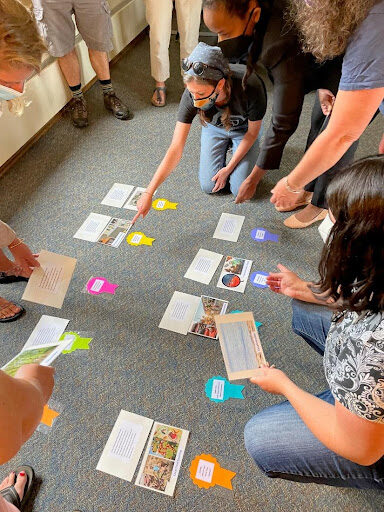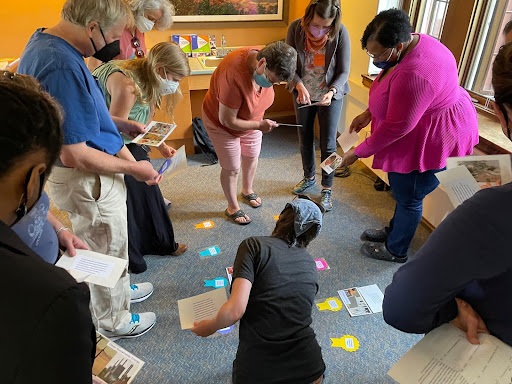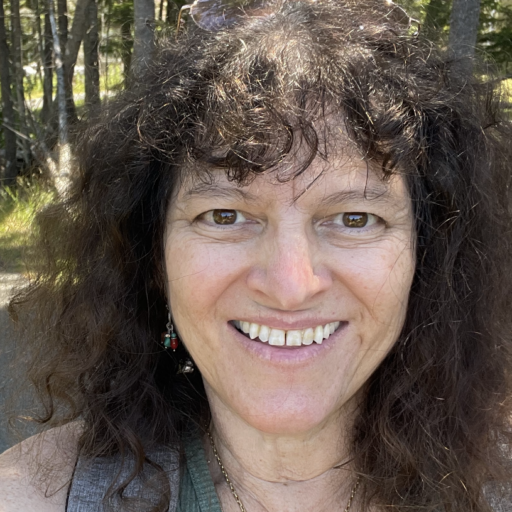Picture a balmy late July day in 2022 at the Schoodic Institute in Acadia National Park, Maine. If you were standing on the lawn in front of the classic two story, multi-colored, ornately bricked Rockefeller Hall, you would smell crustacean-crusted brackish air, and be listening to the rhythmic wash of the ocean against the water-worn, smooth, lichen-coated cliff faces of Schoodic Point. Gathered inside of the Education and Resource Center (within Rockefeller Hall) is an old wooden window filled meeting room with a large conference table at one end. The students are science teachers and it is the first day of a week-long service retreat with the Technical Education Research Centers (TERC) organization, funded through the MacArthur Foundation. The purpose: to unpack climate and equity, also known as climate justice, education.
I was invited to this week-long conference, along with 11 other teachers from across the nation (four urban, four suburban, and four rural), to learn from experts and each other on ways to influence climate justice in the next generation. At the retreat, we studied how climate relates to equity with a series of guest speakers that included ecologist Lyanda Haupt, Reverend Mariama Whitehammond, psychologist Dr. Megan Bang, and climate communication scientist Dr. Susanne Moser. We were brought together to consider best practices for effectively teaching students from small to large communities. Before the first day of the conference, each teacher was asked to prepare a 20-minute climate and equity lesson to use with the group that would serve as an ice breaker and provide a way to get to know that teacher and their teaching style.
Now it is my turn to teach, and the 11 teachers, along with TERC staff Drs. Brian Drayton, Folashade Solomon, and Gillian Puttnick, are playing the role of the students. Together, they match randomly distributed cards containing domain-specific vocabulary to a set of cards containing high-quality photographic images. For this lesson I used 10 matching sets of cards. Each participant began with one card, either a description or a title of a project, and then was tasked with finding its match in the hands of another participant. When these two persons found each other within the throng, they became a team. They read and discuss the information about the project that they now represent. They imagine that they are serving on a panel that will award the winners of a climate change initiative an array of meaningful prizes and funding. Soon the room erupts with discussions about which of a variety of awards will best serve the vastly different projects. The awards are as varied as the projects and this causes deliberation and negotiations in the area of the room where the awards have been set across the floor.
The participants are using their abstract problem-solving skills to defend and justify their perspectives. Discussions are born in the room; the participants are anxious to regroup and present their thinking. Time is flying and the class is driving the learning.
Within minutes, the room of teachers seems to lose the sense that they are engaged in a lesson. They have become acutely focused on trying to figure out what would be the best use of resources to mitigate climate change and bring justice to all. I am smiling because this lesson exceeded my engagement dreams. After 15 minutes, a timer goes off and everyone returns to the conference table to share the projects they are representing as well as to unpack their justifications.

Flores, T. (2022). Teachers at Schoodic Institute discussing which award is best to grant to what project. [Photograph].
Participating teacher Ronnie Vesnaver said, “I love how the activity firstly taught about grants and the methods for how people and organizations can enact change. It gave students a real-world understanding of how things get done. Secondly, I liked that it required participants to engage with a partner to discuss their ideas. Thirdly, I think it was great that it got us out of our chairs and onto our feet!”
My Process
In designing this climate justice lesson, I wanted to put my best foot forward. To do this, I needed to draw upon my resources as a second language English teacher and create a lesson that included positive engagement, body movement, tactile prompts, conversation, and climate vocabulary, all supported by quality photographs. Further, I wanted my lesson to place the students in the driver’s seat and leave me in a peripheral role. I wanted to focus on hopeful solutions rather than habitat loss dread. I wanted there to be no possibility of wrong answers. I wanted the lesson to be flexible for time constraints. Needless to say, coming up with the details of this lesson kept me up for a few nights.
I already knew a lot about climate change. I had been tracking the sobering data on loss of species, ice sheets, and increasingly severe natural disasters. I had attended several conferences put on by the Earth Science Information Partners (ESIP), a foundation of data sharing partners who come together annually from earth science communities across the globe. I had written and published a gamified climate change teaching app through a grant I received from ESIP. However, I had not actually developed my own climate lessons beyond talking with classes and having them number-crunch glum statistics, like storm severity and ice sheet/sea-level data sets. When I thought about it, I had never even considered writing the sort of lesson that was being asked of me now.

Flores, T. (2022). Teachers at the Schoodic Institute finding their partners by matching the project description to the illustrated title. [Photograph].
The biggest obstacle I had was that the lesson was supposed to be about climate equity and I wasn’t positive what “climate equity” meant (also referred to as climate justice during the conference). After some time, I interpreted climate equity as every solution needing to address the whole global population and not just the needs of more developed nations.
Climate change is an issue that will elicit a range of emotions from students.
My hope is that this lesson is highly adaptable for other teachers, regardless of the discipline or grade level. I also want the resources to be useful and flexible for additional lessons. I already used the image cards for a writing project after having used it for the justice panel. Also, this lesson can be used with students who already have an understanding of climate change and equity or it can be used as a way of introducing to the topic.
In the end, climate change is an issue that will elicit a range of emotions from students. I have learned that common responses include panic, worry, anger, and apathy. Just because it’s a loaded issue does not mean that we should avoid the topic. One big takeaway from attending the conference in Maine was that it’s our current students who are precisely the ones needed to address this issue. I wanted to empower my students to feel a sense of agency as they are called upon to be part of the solution.
After I led this lesson with other teachers and with students, I got resounding positive feedback. The aspect of this lesson that struck a chord with the other teachers and TERC group was its focus on positive outcomes. When I taught it in my high school classes, I got this feedback from my students:
“It really had me thinking about the earth and what can we do to prevent an outcome of destruction.” – Ty,12th grade
“It is interesting how we get electricity, transportation, or other things out of nature. We also learned about culture, like the indigenous one and it was cool.” – Alyssa, 12th grade
“I really liked that “exercise” because it was trying to find what picture matches the card and putting a lot of thinking into what we’re doing. It was pretty fun.” – Kayleia, 9th grade
Every time I deliver this lesson, I learn about the ways my students think and it fosters my classroom coming together as a community, just like it did for the teacher group in Maine. I have been surprised how engaged students become, how invested they seem in choosing the appropriate award for each project.
Lesson Description
The participants consider themselves as a panel for an environmental organization whose job is to award climate justice projects with meaningful prizes including funding. Each participant is given either a labeled image or a description of a project at the start of the lesson. Assigning cards can be done randomly or intentionally. The first task is for the participants to organize themselves into pairs by matching the project description to the illustrated title. Once they are in pairs, they discuss the project, its scope, and why it would be beneficial in addressing climate injustice. This lesson is designed to work with any level of background knowledge and the cards contain all the information that the students will need for their discussions. The matching photographs are used to represent what might otherwise be challenging vocabulary. Once the pair feels they understand the project, they review the possible awards and try to decide which one would best help move the project forward. Depending on the involvement of the group they may become animated as they negotiate with other groups for a mutually desired award. The last step in the lesson is that the groups join in a whole class discussion where they are tasked with presenting the project that they are responsible for and give justification for giving it the award they chose. If excess time remains, the participants could conduct research to understand the scope of the projects even more. The time frame will vary significantly for this last phase depending on the size of the class.
In preparation for the lesson, I printed out three things: award labels, project descriptions, and the set of project illustrations. These things are then glued to index cards and/or award certificates, and laminated. For my lesson I prepared 10 possible awards and 10 sets of cards to represent 10 projects. I took the images I used from magazines I had laying around (i.e., Smithsonian, Hadassah, AAA Travel Guide, Consumer’s Reports, and NEA Today), but it’s best to source your own high quality photographic images as they are likely to be brighter and pop more for your lesson. While the descriptions are written for a high school audience, the wording could be changed to match the reading level of the students anywhere from fourth grade to adults. For example, the card for 3rd Millennium Housing is written: As the population increases, humans will benefit from rethinking house/shelter design to use more Earth friendly ways in building/construction practices. This study will generate recommendations humanity around the globe can use to reduce the carbon footprint and conserve scarce resources. It could be adapted to something like: Today we know we should make houses that are more friendly to the Earth. This project will figure out how to do this.

Awards to be matched with projects.
Final Thoughts
The lesson was so many things all at once—an ice breaker, a community builder, an introduction to the complex reality of climate change, and an uplifting affirmation that while people got us into this mess, we have the power to get ourselves out of this mess. Outside it was a cool day and the sea mist wafting through the fragrant red pines reiterated that active hope lives and there’s still time to inspire our students, this critical frontline generation, to act in the holy battle for our Earthly ecosystem. I hope this lesson opens the windows of imagination for you and your students as successfully as it did for my summer cohort in the cool mists of Maine and my students in the dry heat of New Mexico.
Appendix
| Project Titles | ||||
| Award #1 | Award #2 | Award #3 | Award #4 | Award #5 |
| Presentation before the Full Assembly United Nations annual meeting | $100,000,000 Research grant from the NSA | $20,000 and a 1-hour prime time segment on CBS | Staffed laboratory and $5,000,000 in resources for ONE year | 30-minute segment on CBS 60 Minutes |
| Award #6 | Award #7 | Award #8 | Award #9 | Award #10 |
| Four-page spread in Scientific American Magazine | $50,000,000 Research grant from the NSF | $20,000 Research grant from NSF | Booth at the Earth Science Information National meeting | Front page article in the Sunday edition of the New York Times |
|
Project Descriptions (more or fewer projects are used per class or group size) |
| Fossil fuels and other non-renewable sources of energy are problematic for continued life on Earth, as they are the largest contributors of climate change. This research proposes to step up the pace for mass scale global alternatives of clean fuel sources. |
| A massive contributor to climate change is the byproduct of the global shipping industry. Much of this need is fueled by a demand for nutritional sustenance. This research will provide recommendations for communities to produce the bulk of nutritional needs from the immediate surrounding area. |
| Each inhabitable continent is populated by Natives, those who have been there since before industrialization. This groundbreaking study will call upon Indigenous peoples and owners of first knowledge to inform and publish alternate practices of Earth-sustainable sourcing and habitation. |
| A research project that will culminate in proposals to install sustainable farming communities inside large urban areas globally. This project suggests significant reduction of transportation costs and includes replacing concrete surfaces with vegetation and reforesting abandoned roadways. |
| As the population increases, humans will benefit from rethinking house/shelter design to use more Earth-friendly ways in building and construction practices. This study will generate recommendations for people around the globe to reduce the carbon footprint and conserve scarce resources. |
| A large contributor to climate change is carbon released from the transportation industry. This study will culminate with a strategic plan to retool the transportation industry to 3rd Millennium standards in line with an initiative for global best practices. |
| Humanity has irreparably outgrown, used up, and spoiled the resources on planet earth. We are a consuming species and this research will focus on sustainable, long-term space travel so that a select few of us are able to cross the universe until we find new worlds to inhabit. |
| In the near future due to climate change, there will be mass migration of humans from coastal regions that are no longer hospitable. Billions of people will need to relocate in short order. This is a plan to coordinate an international treaty to lay a foundation for this unfortunate but certain event. |
| Much of the Earth’s forests and open spaces have been stripped of vegetation due to human development, mining, deforestation, and wildfires. This project will culminate with an international plan that identifies bare areas of the Earth to plant with indigenous species of flora. |
| Most of the Earth’s surface is under the ocean. This water is salinized and of limited use as a resource for land life. This project will develop global solutions for mass-scale desalination. Fresh water will be sourced in environmentally safe ways for consumption and other water uses. |
Tanya Flores is a teacher from New Mexico with a master’s degree in multicultural education from the University of New Mexico. She specializes in teaching English language learners and has taught elementary, middle, and high school for the past 14 years. She currently teaches at Bernalillo High School in Bernalillo, New Mexico, having taught science, mathematics, business, and English language development. She has presented at the national and local conferences of the National Science Teachers Association (NSTA), is a grant recipient of Earth Science Information Partners andNSTA, and has served as a Museum Fellow with the New Mexico Museum of Natural History. Tanya can be reached at tflores@bernalillops.org.





